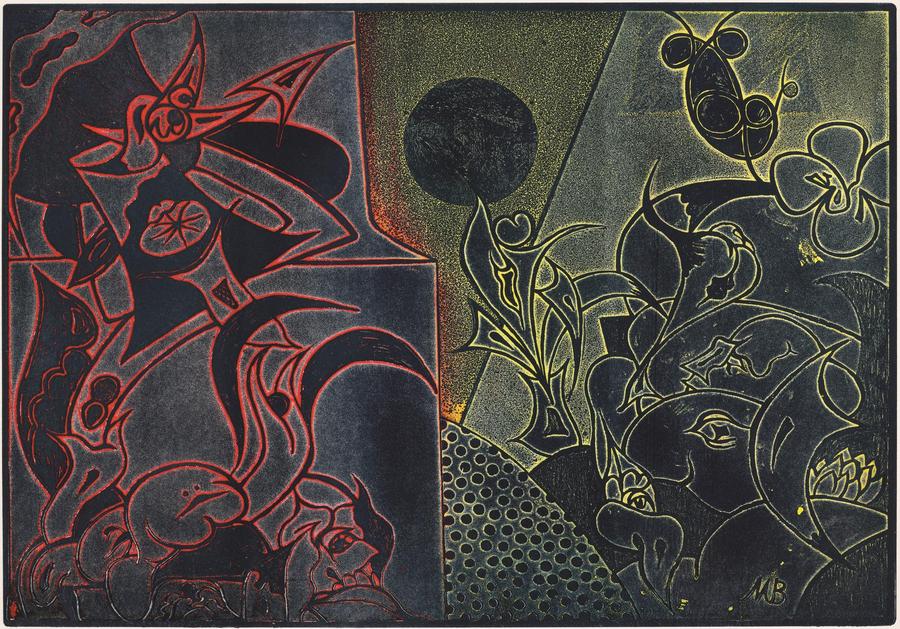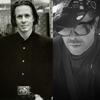Rediscovering Martin Barooshian: Museum of Fine Arts, Boston Adds 35 Barooshian Works To Its Collection
- BOSTON, Massachusetts
- /
- February 28, 2022

BOSTON (February 28, 2022)—The Museum of Fine Arts, Boston (MFA), and the Martin Barooshian Art Trust are pleased to announce that the MFA has added 35 additional pieces by Martin Barooshian (1929-2022), to its collection. The acquisition includes important woodcuts and etchings as well as one monotype and three preparatory drawings. The MFA acquired its first work by Barooshian in 1950.
Barooshian, a Boston native, was an American surrealist painter and an exceptionally accomplished printmaker. Barooshian rose to prominence during the 1950s and 60s, but his fame waned over time. There has been resurgent interest in his artistic contributions, including the publication of a biography and catalogue in 2020, and the MFA’s acquisition represents a substantial step in his rediscovery.

In a New York City art world insistent on non-figurative conformity, Barooshian struck out on his own path. The resulting abstract surrealist prints and paintings, which fuse art historical, modern, and contemporary influences, are unique, singular, and increasingly considered by many to be ahead of their time. With a printmaking output spanning 60 years, Barooshian’s oeuvre incorporates a broad variety of media: woodcuts, lithographs, etchings, and monotypes. His colleague and friend Willem de Kooning called Barooshian “a printing magician.”

Barooshian garnered his earliest national recognition when “discovered” by John Taylor Arms for his woodcuts, which fused traditional techniques and content with modern form and color to convey the paranoia and loss of innocence of the Atomic Age—perhaps tinged with hopefulness. Soon thereafter in 1952, the Library of Congress acquired his first major woodcut portfolio. Perhaps Barooshian’s greatest contribution to printmaking was with a method known as color viscosity printing, which dominated his output starting about 1956. During his stay at Atelier 17 in Paris, Barooshian evolved the technique, pushing its limits in order to reach his artistic vision of imagined realities and dreamscapes. By incorporating various methods including hard ground, soft ground, mezzotint, and aquatint on a single zinc plate, Barooshian created complex, polychromatic images solidifying his reputation as one of viscosity printmaking’s most important masters.
Patrick Murphy, Lia and William Poorvu Associate Curator of Prints and Drawings at the MFA, called Barooshian “a consummate printmaker, whose intriguing and oddly overlooked body of work deserves to be celebrated alongside that of mid-century contemporaries like Hayter, Helen Phillips, Fred Becker, and Gabor Peterdi.”
“This extraordinary gift includes a number of compositions in multiple impressions—state proofs showing the evolution of work on the plate, or variant inkings demonstrating the artist’s characteristic experimentation with color, as well as preparatory drawings, and will make the MFA a destination for the study of Barooshian’s prints,” said Murphy.
“The recent rediscovery of Martin’s work has been very exciting, and this honor solidifies his legacy,” said Michael Russo, curator of the Martin Barooshian Art Trust. “Martin saw this acquisition as a full-circle homecoming. When he was a boy and student, the MFA represented all of his dreams, and he fantasized that someday the MFA would have a large collection of his art. He lived to see it happen.”
About Martin Barooshian
Martin Barooshian was trained at the School of the Museum of Fine Arts, Boston, Boston University, Tufts University, and Atelier 17 in Paris. He has been called “Pablo Picasso meets Stan Lee…who has always defined his own style” by Boston Globe critic Cate McQuaid. Addison Gallery curator Susan Faxon described Barooshian as “an artist whose sweep was wide…and whose exuberance, inventiveness, imagination, and artistic commitment were boundless.” Barooshian was at the center of several critical art movements: innovating color viscosity printmaking at Atelier 17, overseeing the seminal Pratt printing workshop in NYC for over a decade, and serving as the president of the Society of American Graphic Artists. He was taught painting by Karl Zerbe, lithography by Gaston Dorfinant, and intaglio etching by Stanley Hayter; he was friends with Armin Landeck and Gerald Geerlings, de Kooning and Paul Jenkins; he taught Barnett Newman to make lithographs. His story is the story of mid-20th-century American art. More information is available in Martin Barooshian: A Catalogue Raisonne of the Prints, 1948-1970 by Michael Russo, and at www.martinbarooshian.org.
About the Museum of Fine Arts, Boston
Founded on February 4, 1870, the Museum of Fine Arts, Boston (MFA), stands on the historic homelands of the Massachusett people, a site which has long served as a place of meeting and exchange among different nations. The Museum opened its doors to the public on July 4, 1876—the nation’s centennial—at its original location in Copley Square. In 1909, the MFA moved to its current home on Huntington Avenue and today, the Museum houses a global collection encompassing nearly 500,000 works of art, from ancient to contemporary.
Contact:
Ashley BleimesMFA Boston
617-369-3446
ableimes@mfa.org
















